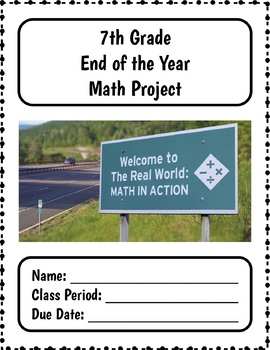7th Grade MATH End of Year Summative Project + Distance learning
- PDF
What educators are saying
Description
****Over 1200 sold! Get this product for cheap while you can!!!*****
This is a great summer school packet as well!
*If you are looking for 6th grade project or a remediation project check out my 6th grade end of year summative project!*
*If you are pre-planning for next year, Check out the discounted Spiraled Common Core 7th Grade Bell Ringers**
Geometric Dream House Project!
After Testing is finished, your students don't want to work on worksheets or regular skill and drill. Instead, they want to be empowered with the opportunity to apply their knowledge in the real world with a fun and engaging multi-day project!
This is a 10 part project that requires little teacher involvement. Students can work in groups or complete individually. This 10 part project includes *every* standard possible in a culturally responsive curriculum that is aligned to Common Core Standards for 7th Grade Mathematics.
This Is a wonderful wrap up to 7th grade material, OR can be used as enrichment of 6th grade standards OR as a remedial activity for 8th grade mathematics.
***Updated with Answer Key***
Part I: Part- Time Job
Standard: 7.NS.A.1.A-d, 7.MS.A.3, 7.NSA.2,a-d
I can add, subtract, multiply and divide rational numbers using real world scenarios.
Part II: Tracking your money
Standard: 7.NS.A.1.A-d, 7.MS.A.3, 7.NSA.2,a-d
I can add, subtract, multiply and divide rational numbers using real world scenarios.
Part III: Order Up!
7.EE.1: I can combine like terms and apply it to real world scenarios
Part IV: Determining the Cost of a Field Trip
7.EE.2: I can solve and apply multi-step equations to real world situations
7.EE.4 I can use variables to represent quantities and inequalities/equations through reasoning
Part V: Inequalities with Real World Application
Directions: Write, Solveand Graphthe inequalities according to the real-world scenarios below.
Standard: 7.EE.3
Part VI: Better Buy Activity:
7.RP.A.1: I can compute Unit Rates associated with ratios of rational numbers.
Part VII: Proportional Relationships
Part VIII: Nike Super Sale
7.RP.A.2 a-d: I can calculate the percent increase, percent decrease, percent off, markup, markdown, sales price, and taxes using real world scenarios.
Part IX: 2020 Election Probability
S.P 5-7
Part X: Student Elections -- Sampling & Measures of Center
SP 1-4


